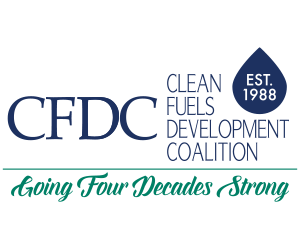Commends Daschle HOLC Alliance Fight for National Higher Octane Gasoline Standard in SAFE-2 Rule
Washington D.C., June 25, 2021—The Clean Fuels Development Coalition (CFDC) called a recent letter from automakers in support of high octane low carbon fuels further validation that ethanol has a key role to play in protecting public health and increasing the efficiency of current and future vehicles.
In a letter to former Senate Majority Leader Tom Daschle who is the Chairman of the High Octane Low Carbon Alliance (HOLCA), the Alliance for Automotive Innovation (AAI) said liquid fuels will continue to be widely used well in to the future. AAI is the singular voice for the auto industry representing 38 companies producing 99 percent of the light duty vehicles sold in the Unites States.
The Alliance wrote “Gasoline will continue to play a vital role in transportation for years to come. The use of high octane low carbon liquid fuels would simultaneously support vehicle performance, including fuel economy, and further reduce greenhouse gas emissions. Such benefits would be realized by new and existing internal combustion engines and therefore should be encouraged as additional solutions as soon as possible to maximize environmental benefits across the fleet.”
These environmental and public health benefits are consistent with the Biden Administration’s emphasis on Environmental Justice and protecting the health of urban and minority residents. AAI told Daschle that “The use of HOLC fuels…can provide an important bridge in reducing emissions in low-income communities during the transition to vehicle electrification.”
The automakers’ letter also noted that “High octane, low carbon fuels provide the benefit of lower aromatics, and therefore lower exposure to toxics, when combusted in a vehicle.”
In a letter to EPA Assistant Administrator Joe Goffman, HOLCA Chairman Daschle warned that new science confirms that the rapid proliferation of gasoline direct injection (GDI) engines will substantially increase the most dangerous ultrafine particulate-borne toxic emissions unless gasoline aromatics levels are dramatically reduced.
EPA is required “from time to time” to reduce gasoline aromatics by a mandatory provision which Daschle co-authored to the 1990 Clean Air Act Amendments.
In previous correspondence with EPA, CFDC has stressed that in developing the current rule the agency solicited comment on octane, asking what should be the appropriate levels, and how octane could be increased consistent with Title II of the Clean Air Act, which requires a reduction in toxics “to the greatest achievable extent”.
“CFDC Executive Director Doug Durante said “ We would expect at a minimum for EPA to again open this dialogue by including it in the proposed rule. Ethanol producers, trade groups, health organizations, agriculture groups and all other stakeholders should be contacting EPA and their Congressional representatives right now to make sure EPA does so.”
According to Durante, the AAI letter represents a timely endorsement for HOLCA’s efforts to encourage EPA and the Biden Climate Team to recognize the tremendous “two-fer” benefits that ethanol’s superior octane properties bring to automakers, consumers, and the environment and public health by substantially reducing both carbon and toxics emissions from the transportation sector.
“EPA has the authority and the responsibility to increase octane and control toxic emissions. The SAFE Rule is without question the appropriate vehicle to do so.”
CFDC Member Jim Seurer, CEO of Glacial Lakes Energy, said “We have shown higher blends like E30 we use in South Dakota can double the benefits the RFS has provided. The industry needs to let EPA know as they develop their rule to improve mileage and reduce carbon emissions, we have a product that will do exactly that if they remove the regulatory obstacles they have unlawfully erected to the use of E30 HOLC fuels.”
“As Senator Daschle has stated, the RFS has been the launch vehicle for ethanol, and it has been a win for the environment, energy security, and agriculture, but octane can be the booster rocket to keep ethanol in orbit,” said Seurer.
EPA plans to release a notice of proposed rulemaking (NPRM) on the SAFE Rule by late July.
For further Information Contact Doug Durante cfdcinc@aol.com. 301 537 8830
